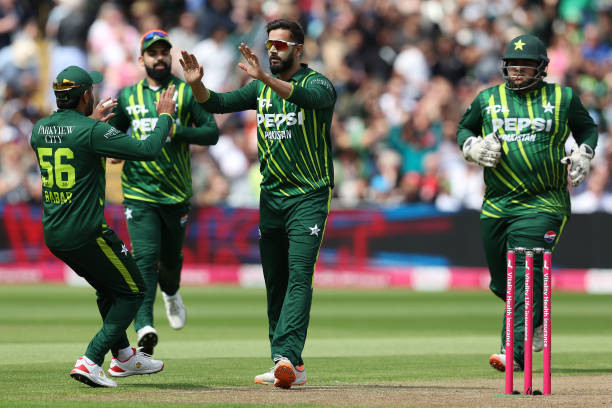Pakistan cricket needs to improve to move forward. Their recent performances have been inconsistent, and their lack of clear intent is evident. This could make their T20 World Cup journey challenging.
There are a few areas for concern. The team lacks a settled opening partnership and a strong middle order. While some might argue Zimbabwe and Uganda have better middle orders at this point, that’s debatable.
Pakistan’s bowling attack also needs work. There seems to be a disconnect between the batting and bowling units. Ideally, these units should support each other. When the batting fails, the bowling takes the brunt of the pressure, and vice versa.
The key problem is the lack of consistency. Pakistan needs both batting and bowling to click on the same day to win matches.
1) Ineffective Openers?
Babar Azam and Mohammad Rizwan are Pakistan’s opening batsmen, but their consistency might not match that of other teams. Look at Australia, for example, with the explosive pair of David Warner and Mitchell Marsh. Similarly, England boasts the in-form duo of Jos Buttler and Phil Salt.
The question is: can Babar Azam and Mohammad Rizwan score at a high strike rate consistently? If they need to maintain an average above 150, the risk of losing wickets early becomes significant. They might lack the raw power to fully capitalize on the powerplay overs.
This could be a challenge for Pakistan throughout the tournament. With a benchmark of scoring 65-70 runs in the powerplay for this T20 World Cup 2024, Pakistan’s opening pair will need to find a way to be more aggressive.

2) Pakistan’s Middle-Order Muddle
Fakhar Zaman’s batting is a feast-or-famine affair. While he has the potential to dismantle any bowling attack, he might be better suited to opening the innings. However, there seems to be a preference for Babar Azam to bat at the top, which could be seen as favouritism.
Azam Khan’s selection raises concerns about nepotism. In his short T20 career of 12 innings, he has already registered three ducks and only surpassed 10 runs twice, both against a weaker opponent like Ireland.
Pakistan fans are understandably losing patience, as Azam Khan’s fitness and fielding abilities (including wicketkeeping) seem inadequate for the high-pressure T20 format. He currently presents a negative impact on the team’s performance.
Shadab Khan’s inclusion in the middle order is another questionable decision. While a talented all-rounder, his batting record doesn’t justify this role. A single half-century in over 40 matches doesn’t qualify him as a reliable middle-order batsman. Pakistan needs to address this issue and find a more consistent solution for their middle order.
3) Bowling Has Talent But Lacks Consistency
Babar Azam’s leadership can be improved. While he has talent, he could utilize his bowlers more effectively by strategically deploying them and fostering confidence in their abilities.
Shaheen Afridi’s recent form is a concern. He’s been conceding a lot of runs and needs to regain control. Mohammad Amir remains a valuable asset, but he thrives with support from the other end.
Shadab Khan’s effectiveness in the T20 World Cup is uncertain. While talented, the T20 format’s aggressive nature might expose limitations in his strategy against top batters. Including Imad Wasim in the team composition offers a strategic option, but the final decision should be based on a comprehensive analysis.
Pakistan’s pacers possess raw pace, but translating that into consistent wicket-taking requires better planning and execution. Shaheen appears to lack his usual bite, and Haris Rauf’s struggles with control need to be addressed.

